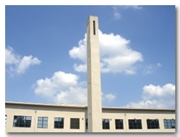Kumamoto and History of Hansen's disease

Honmyo Temple (Homyoji) in Kumamoto, deifies Duke Kiyomasa Kato who constructed Kumamoto Castle. It is said that Duke Kiyomasa was worshiped as a protectorate god of people inflicted with Hansen's disease drawing sufferers from all over Japan to Honmyoji. Hannah Riddell, who was selected by the Church Missionary Society in England to come to Kumamoto in 1895, witnessed miserable leprosy patients begging for mercy on the approach to this temple and made up her mind to dedicate her life to the salvation of Hansen's disease patients and opened Kaishun Hospital also known as the Kumamoto Hospital of the Resurrection of Hope. When support donations from her home country ceased and hospital administration became difficult, she approached then Japanese Prime Minister, Shigenobu Ohkuma and received some support. This led to the establishment of the domestic law entitled "Regarding leprosy prevention". Under this law, 5 public sanatoriums were established in 1909. One of them was Kikuchi Keifuen. as Kikuchi Keifuen.
About the same time, a Catholic priest named Cole was also surprised to find wandering leprosy patients around the Honmyoji area and opened the"Tairouin" leprosy center in the city which has been taken over and is maintained to date for ex-patients' use.
This first leprosy law (est. 1909) was mainly intended to apply to those with Hansen's disease who were not contained in established institutions, but another leprosy prevention law was promulgated in 1931 which applied to all people with Hansen's disease.
The national goal set for the number of the patients accepted into care was 10,000 which continued after WWII. Kikuchi Keifuen became the largest sanatorium in Japan and increased its number of beds to 2,200.
In 1943, the effectiveness of the medicine called "Promin" was announced in the U.S. and gradually became identified as an effective treatment in Japan. After listening to specialists' opinions for future Hansen's disease policy, the then standing leprosy prevention law was revised in 1953 with little change to previous provisions, but with a stronger emphasis on quarantine.
In 1954, the Tatsudaryo incident occurred. (Children born of patients with leprosy but with no leprosy themselves were denied schooling by a strong petition from the school PTA.)
In 1996, the Leprosy Prevention Law was abolished and at the same time "the Law regarding the abolition of the Leprosy Prevention Law "was established to indemnify ex-patients' lives in the sanatorium.
However in 1998, a court action on the unconstitutionality of the Leprosy Prevention Law's national compensation clause was brought to Kumamoto district court and after 3 years, the suitor won. A basic agreement on the reconciliation was concluded, and an apology along with verification and support for the discharged patients was incorporated.
In 2003, a hotel reservation made by ex-Hansen's disease patients was rejected by a hotel in Oguni, Kumamoto. Public accusation against the hotel in question spread at first, but later when Jichikai (patients' association) refused the hotel administrator's apology, slander against Jichikai occurred. The significance of this incident was that it showed that misunderstanding about this disease still existed.
Now, the annual number of new occurrences of Hansen's disease's in Japan is so few that it has almost been completely stamped out. However, the reality that some who used to be afflicted by this disease still can't talk about it openly exists. We hope that this is food for thought for each of us.
